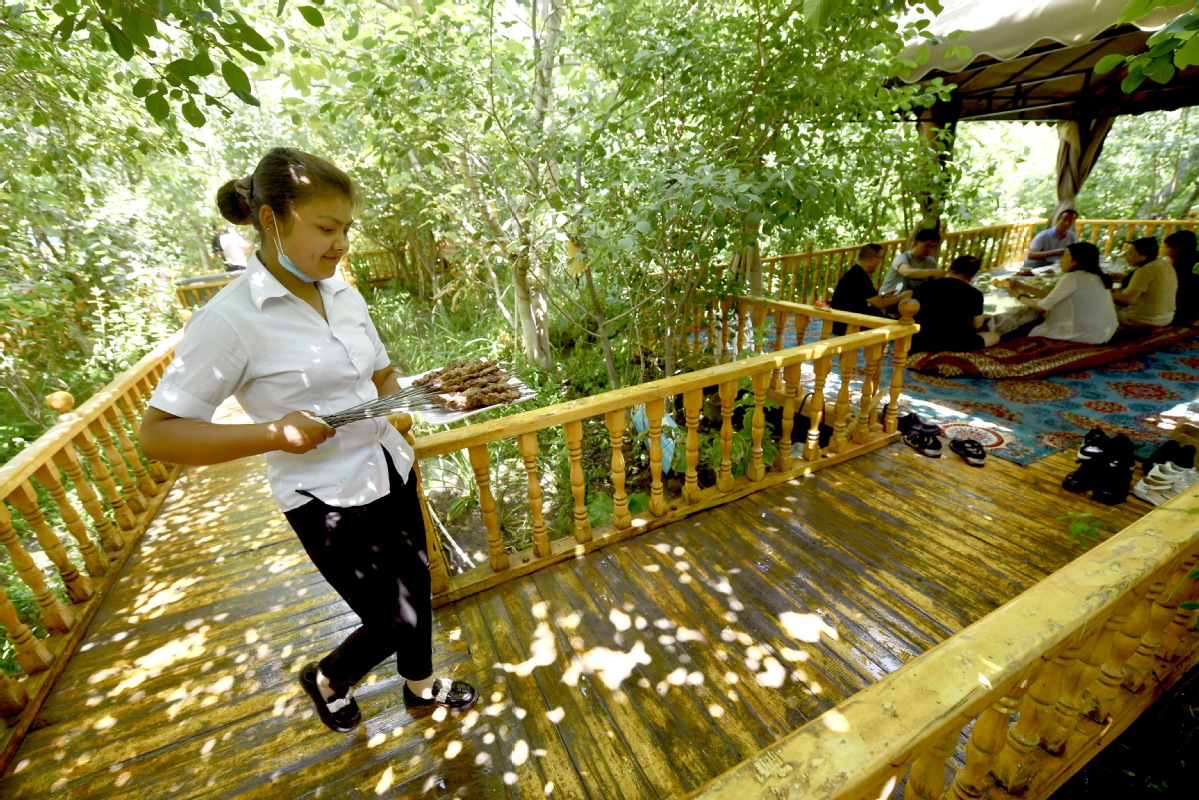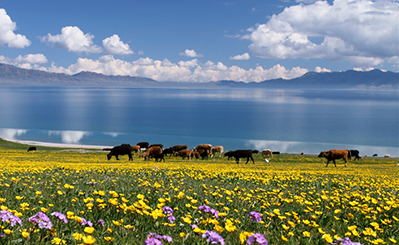Planting the seeds of success in Xinjiang

A villager serves tourists at her homestay along the Dushanzi-Kuqa highway in Kuqa, Xinjiang Uygur autonomous region, last month. [Photo by Wei Xiaohao/China Daily]
Green upgrades, skills training helping to improve ethnic groups' livelihoods
Maryem Wullayim rides her electric bike about 8 kilometers every day to check on tomatoes and other plants in a greenhouse.
She nurtures them tenderly, finding the best ways to water and fertilize them so that she can apply the same care to her own crops.
"We have our own 2-hectare plot, growing maize and other staples," the 31-year-old said.
"I hope to learn as much as I can here, to improve myself."
For the past few months, Maryem has been working at the Shuifa Modern Vegetable Industrial Park in Shule county, Kashgar, Xinjiang Uygur autonomous region.
The park, set up with support from East China's Shandong province, covers more than 300 hectares, with total investment of over 1 billion yuan ($154 million).
Its first phase boasts state-of-the-art agricultural technology, ranging from smart temperature and moisture management greenhouses to coconut-husk test-bed soils and customized insulation walls.
Shuifa, which provides at least 3,000 jobs to members of local ethnic groups like Maryem, expects to reap about 1.5 million metric tons of fresh produce from the park each year.
"We're at the global forefront of the industry with what we are doing here," its general manager, Ni Xiangxiang, said.
About 1,400 local farmers are also renting farm plots from the company to hone their agricultural practices for higher yields, he said.
Maryem, who makes about 2,300 yuan a month at the site, also aims to rent a plot from the company and run her own farm with maximum efficiency.
"Before coming here, I was a housewife and felt I wasn't doing enough to help with the family income," she said.
"All this will make a difference to us."
Her experience is a clear example of the latest improvements in the livelihoods of Xinjiang's ethnic groups through skills training, green technology upgrading and rural vitalization projects across pillar industries including food production and tourism, helping more communities share in the region's growth and development.
The regional economy recorded impressive growth in the first half of the year, with GDP hitting more than 732 billion yuan ($113 billion), up nearly 10 percent year-on-year, the latest official figures showed.
Primary, secondary and tertiary industries reported stable development. The added value of primary industry was up 3.8 percent year-on-year, that of secondary industry rose 10.5 percent, and tertiary industry saw a 10.3 percent increase, the regional government said.
At Nanda New Agriculture, which focuses on dairy and other specialty food and beverage products, an 800-strong workforce comprised mostly of members of Kashgar's ethnic groups is reaping the latest benefits of regional growth.
Maryemgul Mehmet-Ali, 34, has been at the industry leader for a decade, working her way up to become its production manager.
"There's a lot of respect here," said Maryemgul, whose husband is also a manager at the factory.
"With a spirit of working hard, to improve ourselves and our livelihoods, we're contributing back to society."
The company produces at least 300 tons of milk and related foods a day.
Yang Tangjuan, its head of human resources, said women make up a little more than half the workforce, with many family members, some spanning three generations, working together, earning an average of 3,700 yuan a month.
"We have the latest green, circular agricultural technology and practices, such as strict quality-controlled and clean glacier-watered cattle facilities, because we know the community places great importance on health and happiness," Yang said.
 Attractions
Attractions Dining
Dining Culture
Culture